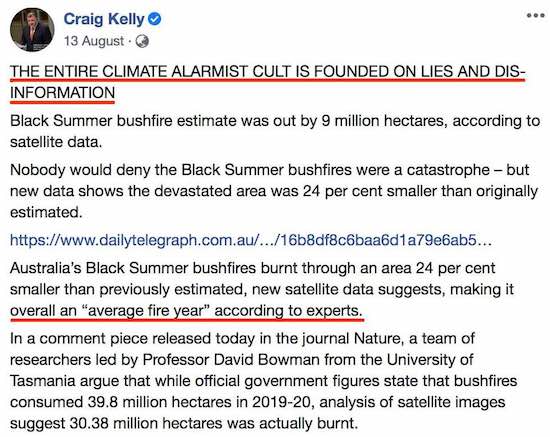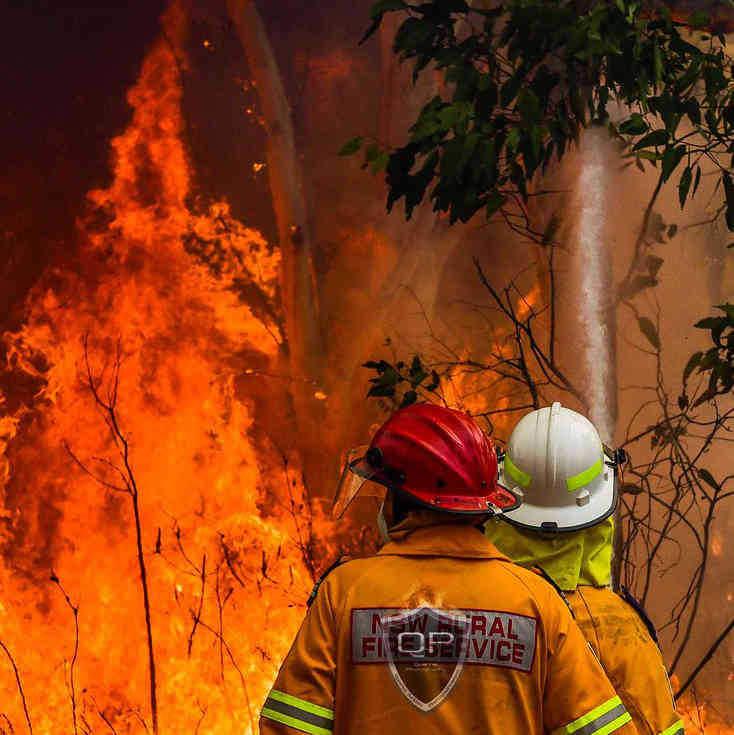Claim
On August 13 Craig Kelly quoted a piece in Sydney’s Telegraph newspaper, as shown here.

Essentially, this makes 3 clear claims:
- That an Australian fire expert said the area burnt by the fires was less than previously thought.
- That this makes this an average fire year according to the experts.
- That “the entire climate alarmist cult is founded on lies and disinformation”.
Analysis
#1 Was the area over-estimated?
Here is the report by Professor Bowman (and others). He does say that satellite data indicates a smaller area burnt than Government estimates.
But he doesn’t say the Government figures are wrong. Rather, he says: “Both approaches have strengths and weaknesses”. But he believes the new data is more useful.
There are no lies or misinformation in these two sets of figures – just two different estimates.
#2 An average year?
The report does say that in area burnt, these fires “did not differ statistically from the historical average”.
But the report also says that: ” almost 20% of Australia’s eucalyptus forest coverage burnt — a figure more than 7.5 times higher than the annual average percentage burnt for the past 18 years”.
It is clear that area burnt is NOT the most important statistic for measuring the effect of bushfires. Other important factors are:
- lives lost,
- damage caused,
- species lost,
- the value and type of land burnt, and
- the severity and ferocity of the fires.
On many of these factors, these fires were “unprecedented”. Because these fires burnt so much precious eucalyptus forest, enormous numbers of species were lost (estimated at more than a billion animals).
Because they burnt in the more habitable eastern area of Australia, many people were affected and many properties lost, or only just saved by the magnificent work of the firefighters.
And over 400 people, mostly well away from the actual fires, died from an “unprecedented smoke‐related health burden”.
And so Professor Bowman and his team said:
“The extraordinary scale and intensity of the fires were driven by climate conditions not seen in a century: three years of drought, including three consecutive, anomalously dry winters. This weather is consistent with predictions that global warming will result in conditions that increase the risk of fire.”
#3 An alarmist cult based on lies?
The paper makes it clear that, based on the best information, we should be warned:
“The 2019–20 fires marked a historic crossroads. A national crisis of this magnitude, which will probably happen again, requires a national solution.”
It also pointed out how some politicians and some media were themselves the sources of misinformation::
“Fire scientists and managers had to stem misinformation from politicians and the media suggesting that the fires were not unusual historically and were not linked to climate change.”
Verdict

#1. Area burnt less than previously claimed.
Inaccurate. The report offered a second estimate that was lower and maybe more useful than the previous estimate.

#2 Average fire year?
Not true. The area burnt was about average, but the fires were fiercer and the impacts on humans and environment were much greater.

#3. Cult based on lies?
Not true. The report is very clear that climate change is a serious danger that makes bushfires in eastern Australia far more ferocious and serious.
Almost everything in Craig’s report was misleading. The errors are quite clear if you read the original report. The report even criticises politicians who do this.
Please read the report. And please share this fact check.
Photo Credit: Quarrie Photography on Compfight cc.
